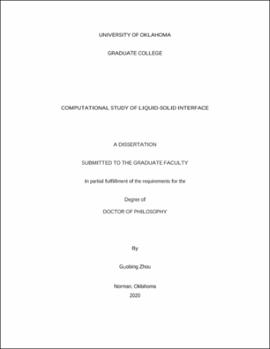| dc.description.abstract | The solid interface is of fundamental importance to numerous scientific and technological fields, such as heterogeneous catalysis, water splitting, electrochemistry, corrosion, drug delivery, tribology, and wetting. However, there is still limited knowledge of the structures and properties of the first adsorbed monolayer at distinct solid interfaces. We perform theoretical calculations to study the interactions between the solid surfaces and the first adsorbed monolayer at the interface, to understand from the electronic/atomic levels how the properties of solid surface influence the adsorption of the first monolayer at the solid interfaces.
In Chapter 3, we developed the force field parameter for the thiolate/defective Au(111) interface. A molecular-level understanding of the interplay between self-assembled monolayers (SAMs) of thiolates and gold surface is of great importance to a wide range of applications in surface science and nanotechnology. Despite theoretical research progress of the past decade, an atomistic model, capable of describing key features of SAMs at reconstructed gold surfaces, is still missing. We carried out the periodic ab initio density functional theory (DFT) calculations to develop a new atomistic force field model for alkanethiolate SAMs on a reconstructed Au(111) surface. Based on the newly-developed force field parameters, the molecular dynamics (MD) simulations showed that the geometrical features of the investigated Au−S interface models and structural properties of the C10S SAMs are in good agreement with the ab initio MD studies.
In Chapter 4, we investigate the wettability transition of the first adsorbed water layer (FAWL) on metal surfaces under a compressive lattice strain. A molecular-level description of a near-surface water structure and a handy manipulation of its properties are relevant to a broad range of scientific and technological phenomena. Through a series of MD simulations, we report the observation and characterization of a low-mobility FAWL and its tunable wetting transition at three metal surface models. The results reveal that (i) there is a formation of the FAWL, resulting from competitive water−water hydrogen bonding and water−solid interactions, which in turn dictates the wettability at water−metal interfaces, (ii) applying compressive lattice strain to metal substrates can induce interfacial wettability transition, and (iii) by adjusting the lattice strains, the bimetallic junction can host a switchable wettability transition.
In Chapter 5, we study the structures and dynamics of the FAWL at distinct titanium dioxide (TiO2) surfaces. The behavior of the FAWL at TiO2 surfaces is critical to the fundamental understanding of TiO2-based applications. Using classical MD simulations, we study the properties of FAWL at four TiO2 surfaces, including the density profile, the angular orientation distribution, the HB structural and dynamic properties, and the vibrational spectra of water molecules in the FAWL. The calculation results demonstrate that the water molecules show distinct adsorption structures and HB properties at the studied TiO2 surfaces, leading to completely different vibrational signatures for the OH groups.
In Chapter 6, we explore the role of interfacial potassium on the surface-enhanced Raman spectroscopy for single-crystal TiO2 nanowhisker by combining experiments and theoretical calculations. For TiO2-based surface-enhanced Raman spectroscopy (SERS) substrates, maintaining a good crystallinity is critical to achieving excellent Raman scattering. we report the successful synthesis of TiO2 nanowhiskers with excellent SERS properties. The enhancement factor, an index of SERS performance, is 4.96×106 for methylene blue molecule detecting, with a detection sensitivity around 10−7 mol·L−1. The DFT calculations reveal that interfacial potassium can form a monolayer structure on the TiO2 surface, resulting in a negatively charged TiO2 nanowhisker surface. Such structures would promote the adsorption of methylene blue molecules and thereby significantly improves SERS performance via the electrostatic adsorption effect.
In Chapter 7, we investigate the friction of ionic liquid (IL)–glycol ether mixtures by combining AFM experiments and nonequilibrium MD (NEMD) simulations. We have measured the negative “friction–load dependence” of IL/oil mixtures at Ti interfaces. Such a negative phenomenon was also confirmed by our NEMD simulations, in which the friction force declines as the normal load increases. NEMD simulations revealed a structural reorientation of the studied IL as the normal load increases, i.e., the cation alkyl chains of ILs change the orientation to preferentially stay parallel to the tip scanning path, similar to the “blooming lotus leaf.” This reoriented IL structures produce a new sliding interface and reduce the friction force. | en_US |
